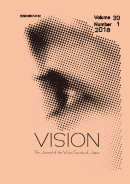
- Issue 4 Pages 161-
- Issue 3 Pages 113-
- Issue 2 Pages 67-
- Issue 1 Pages 1-
- |<
- <
- 1
- >
- >|
-
Masahiro Saito, Sotoshi Nakadomari, Kenji Kitahara, lchiro Kuriki, Kei ...1999 Volume 11 Issue 4 Pages 161-169
Published: 1999
Released on J-STAGE: April 19, 2019
JOURNAL FREE ACCESSWe tried to measure visual extinction level of patients with brain damage using contrast threshold of luminance grating. A grating stimulus was presented unilaterally either in the extinction visual field (contralateral to the lesion) or in the normal visual field (ipsilateral to the lesion), or bilaterally in bothvisual fields. In the bilateral presentation condition, contrast threshold was measured only for grating stimuli presented in the extinction visual field. In Experiment I, two patients with right brain damage were tested and showed a complete extinction in the bilateral presentation condition: the patients could not detect a stimulus in the extinction field even when it was presented in the maximum contrast of the apparatus. In Experiment 2, four new patients with right brain damage were tested in the bilateral presentation condition with stimuli of three contrast levels in the normal field. The results indicated that extinction level could be measured as a change of contrast threshold of luminance gratings. It was also suggested that the extinction rate increased along with the intensity of stimuli presented in the normal field.
View full abstractDownload PDF (9717K) -
Shinya Abe, Naoki Fukaya, Toshio Honda1999 Volume 11 Issue 4 Pages 171-175
Published: 1999
Released on J-STAGE: April 19, 2019
JOURNAL FREE ACCESSIn this paper, we examined the required number of viewpoints for elicitation of the blur in the different conditions between the images of the different depth for multiple-viewpoints image display in which a few parallax images incident to one pupil. The result obtained by Fukaya et. al. (1998) was that when the amount of the image depth increase, required number of viewpoints to elicit the blur decrease. In this experiment, observers see the two randolt ring patterns located in the different depth by one eye. A pinhole-array was put just in front of the eye which has a small diameter and interval. As a result, we found that when the amount of the parallax increases, required number of viewpoints to elicit the blur decreases. And in conclusion, the overlapping state of retina images and amount of the parallax affect elicitation of the blur.
View full abstractDownload PDF (3972K)
-
[in Japanese]1999 Volume 11 Issue 4 Pages 177-182
Published: 1999
Released on J-STAGE: April 19, 2019
JOURNAL FREE ACCESSDownload PDF (3810K) -
[in Japanese]1999 Volume 11 Issue 4 Pages 183-186
Published: 1999
Released on J-STAGE: April 19, 2019
JOURNAL FREE ACCESSDownload PDF (2323K)
-
[in Japanese], [in Japanese], [in Japanese]1999 Volume 11 Issue 4 Pages 187-190
Published: 1999
Released on J-STAGE: April 19, 2019
JOURNAL FREE ACCESSDownload PDF (3476K)
-
1999 Volume 11 Issue 4 Pages 191-194
Published: 1999
Released on J-STAGE: April 19, 2019
JOURNAL FREE ACCESSDownload PDF (1913K)
- |<
- <
- 1
- >
- >|